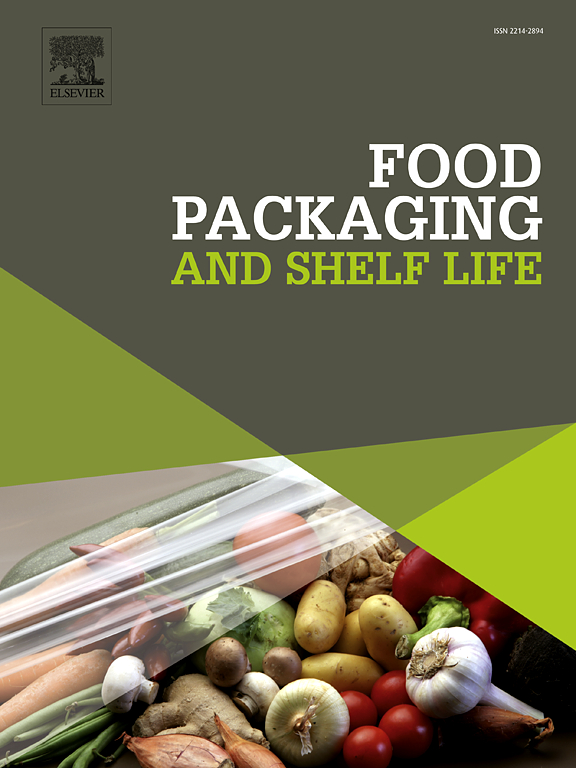Design and characterization of a pea protein/nucleic acid-based biopolymeric film for strawberry preservation
IF 10.6
1区 农林科学
Q1 FOOD SCIENCE & TECHNOLOGY
引用次数: 0
Abstract
The escalating environmental issues related to petroleum-derived plastics have prompted a shift toward sustainable food packaging materials. However, current sustainable alternatives lack adequate barrier and mechanical properties. The use of nanomaterials can present a promising solution to surmount these challenges. This study aimed to develop innovative and eco-friendly film systems formulated with pea protein and deoxyribonucleic acid (DNA) nanoparticles. Control (PF) was designed using pea protein alone. PDF1, PDF2, PDF3, and PDF4 contained both protein and DNA, with nanoparticle quantities of 0.01, 0.1, 0.5, and 1.0 (g/5 g), respectively. Molecular characterization revealed the presence of molecular groups associated with polypeptide chains and nucleic acids, along with their interactions. A high DNA nanoparticle concentration in the film system prevented the formation of an organized structure. Amount of DNA nanoparticles led to slight differences in thickness whereas moisture content (PF: 23.70 %, PDF1: 19.30 %, PDF2: 11.36 %, PDF3: 14.87 %, and PDF4: 15.81 %) decreased compared with the control. Moreover, incorporation of DNA nanoparticles increased the opacity from 1.46 to 4.14 Abs600/mm. PDF2 was ahead in terms of oxygen barrier characteristics. A similar improvement was also observed in water transmission index (WTI) (PDF2: 10.89 %, PDF3: 15.29 %, PDF4: 17.55 %, PDF1: 27.46 %, and PF: 30.89 %). The combination of pea protein with DNA led to a decrease (9.68–6.07 MPa) in tensile strength and an increase (119.49–146.29 %) in elongation at break. PDF2 maintained strawberry quality over 14 days of storage compared to other film systems by reducing weight loss, preserving biochemical properties, and managing microbial load.
草莓保鲜用豌豆蛋白/核酸生物聚合物膜的设计与表征
与石油衍生塑料相关的不断升级的环境问题促使人们转向可持续的食品包装材料。然而,目前的可持续替代品缺乏足够的屏障和机械性能。纳米材料的使用可以为克服这些挑战提供一个有希望的解决方案。本研究旨在开发以豌豆蛋白和脱氧核糖核酸(DNA)纳米颗粒为原料的创新型环保薄膜系统。用豌豆蛋白单独设计对照(PF)。PDF1、PDF2、PDF3和PDF4同时含有蛋白质和DNA,纳米粒含量分别为0.01、0.1、0.5和1.0 (g/5 g)。分子表征揭示了与多肽链和核酸相关的分子基团的存在,以及它们之间的相互作用。高DNA纳米颗粒浓度的膜系统阻止了有组织结构的形成。与对照相比,DNA纳米颗粒的加入导致了厚度的轻微差异,而水分含量(PF: 23.70 %,PDF1: 19.30 %,PDF2: 11.36 %,PDF3: 14.87 %,PDF4: 15.81 %)则有所下降。此外,DNA纳米颗粒的掺入使不透明度从1.46增加到4.14 Abs600/mm。PDF2在氧屏障特性方面领先。水分传递指数(WTI)也有类似的改善(PDF2: 10.89 %,PDF3: 15.29 %,PDF4: 17.55 %,PDF1: 27.46 %,PF: 30.89 %)。豌豆蛋白与DNA结合后,拉伸强度降低(9.68 ~ 6.07 MPa),断裂伸长率提高(119.49 ~ 146.29 %)。与其他薄膜系统相比,PDF2通过减少重量损失、保持生化特性和控制微生物负荷,在14天的储存中保持了草莓的质量。
本文章由计算机程序翻译,如有差异,请以英文原文为准。
求助全文
约1分钟内获得全文
求助全文
来源期刊

Food Packaging and Shelf Life
Agricultural and Biological Sciences-Food Science
CiteScore
14.00
自引率
8.80%
发文量
214
审稿时长
70 days
期刊介绍:
Food packaging is crucial for preserving food integrity throughout the distribution chain. It safeguards against contamination by physical, chemical, and biological agents, ensuring the safety and quality of processed foods. The evolution of novel food packaging, including modified atmosphere and active packaging, has extended shelf life, enhancing convenience for consumers. Shelf life, the duration a perishable item remains suitable for sale, use, or consumption, is intricately linked with food packaging, emphasizing its role in maintaining product quality and safety.
 求助内容:
求助内容: 应助结果提醒方式:
应助结果提醒方式:


